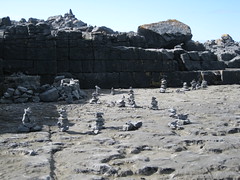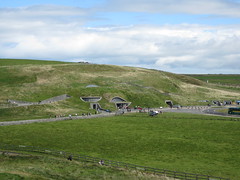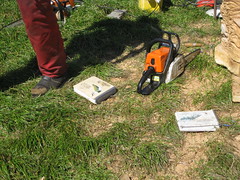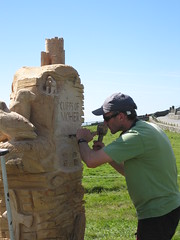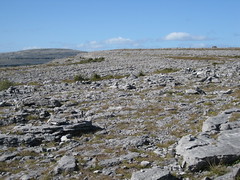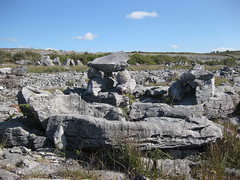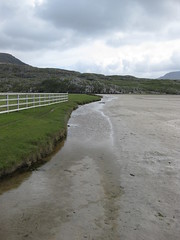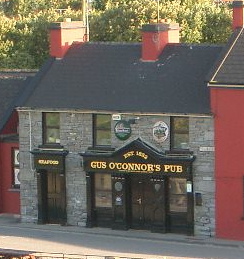 Said goodbye to our little dog Tansy over weekend. I am not one of nature’s dog lovers, but it is amazing how one gets attached to a small bundle of fur, I just wish I had been at home in Tiree with Fiona at the time. At nearly 17 she was very old in doggy years, seemed to be happy to the end and certainly gave a lot of happiness to others, which is a pretty good epitaph for anyone.
Said goodbye to our little dog Tansy over weekend. I am not one of nature’s dog lovers, but it is amazing how one gets attached to a small bundle of fur, I just wish I had been at home in Tiree with Fiona at the time. At nearly 17 she was very old in doggy years, seemed to be happy to the end and certainly gave a lot of happiness to others, which is a pretty good epitaph for anyone.
Author Archives: alan
Last Day — Doolin to Limerick
From Doolin’s harbour side you can see the ferries that ply back and forth to the Aran Islands. The rock is limestone, like the Burren, and the land beneath cut through with caves including the world’s largest stalactite and the submerged ‘Green Holes’, only discovered in the 1980s.
While the Aran Islands stretch across the sea to the North West, to the South West rise the Cliffs of Moher, 200 metres from the sea, shortlisted alongside Kilimanjaro, the Great Barrier Reef and the Grand Canyon to be one of the new seven wonders of nature. There is no beach, no sand or shingle, just sea and shear rock, but surfers travel there to ride the 35 foot wave at its feet.
The Moher visitor centre is dug and buried into the hillside with curved windows cut through the turf; Hobbit Town meets HiTech, The paved, stepped, and wheelchair-access routed area with its viewing points and wall of wave-patterned Burran limestone slabs, ends at widely ignored signs threatening danger to life and limb if one proceeds. You can see why the signs are there; it is not so much the lack of fence or wall between the cliff top path and precipitous edge, but the rock itself. The limestone of the Burran, Doolin coast and Aran Isles has ended and this is younger, softer alluvial rock, at the cliff top often little more than flakes of shale in hardened mud. The tourists peeking over the edge may be secure in footing, but the soft cliff edge itself might shrug them off to fly for a moment amongst the nesting gulls before hitting the water 600 feet below.
And out on the grass beside the forbidden cliff path, an Italian couple set up a video camera looking out towards the rocky headland, and sit in front of it to exchange rings.
Back at the visitor centre a sculptor was hard at work with chisel, angle grinder and chain saw, capturing the spirit of Maher from surfer to sea birds. Shane Gilmore‘s sculptures are found across Western Ireland, and he was commissioned to make this one in situ during the Clare Heritage Week. At Shane’s feet lay a collection of reference books; he explained that if he got some detail wrong, gave a bird the head of a gull and the body of a gannet, someone would be sure to notice.
It is only a short way from Doolin and Maher, and slightly longer of you cut back north to travel across the Burren, but worth it, for its near lunar yet surprisingly fertile landscape. Few roads cut across the limestone countryside but far beneath the ground are subterranean rivers and networks of caves left from past water courses, treacherous as they too can flood rapidly when rain falls and drains through sinkholes and caverns.
At a distance the Burren landscape appears barren, but between the clints, giant paving slabs of grey stone, the cracks, or grykes, are rich with wild flowers and lush grasses that supported communities from Neolithic times, who in turn left their traces in fire circles and ring forts. And near every parking place, each clint is topped with a tiny cairn or sculpture as visitors today still want to leave some trace of their being here, or maybe token of their hoped-for return.
Serendipity and Song — Westport to Doolin
 Westport nestles on the far shore of one of Ireland’s great peninsulas, jutting into the Atlantic, with the Mountains of Connemara to the south and the wild coasts of Achill to the north. Some years ago we camped on Achill Island in late September. Most Irish campsites close after the first week of September but we found one campsite still open although only one other campervan stopped by in the few days we spent there. The site had several permanent mobile homes, and despite the 8 foot banks of grass-topped sand that protected the site each was held to the ground with structures of foot-wide girders to hold them down against the force of the Atlantic winds. We parked close between some of these and as the campervan shook in the night reminded ourselves that these were just mild September breezes, not the wild storms of the winter.
Westport nestles on the far shore of one of Ireland’s great peninsulas, jutting into the Atlantic, with the Mountains of Connemara to the south and the wild coasts of Achill to the north. Some years ago we camped on Achill Island in late September. Most Irish campsites close after the first week of September but we found one campsite still open although only one other campervan stopped by in the few days we spent there. The site had several permanent mobile homes, and despite the 8 foot banks of grass-topped sand that protected the site each was held to the ground with structures of foot-wide girders to hold them down against the force of the Atlantic winds. We parked close between some of these and as the campervan shook in the night reminded ourselves that these were just mild September breezes, not the wild storms of the winter.
This time I had to set my face south cutting across Connemara to Doolin for the night. I took the coast road between Croagh Patrick and the sea, passing the car parks and coaches at its foot where the pilgrimage route begins. Although I’ll forgo the climb on hands and knees of the true pilgrim it would be good to climb it some day for the view and the sense of those who have visited this holy spot for a thousand years.
I do not have a SatNav and somehow at Louisburgh I took the wrong road. As the road narrowed to single track and then grass began to grow down the centre, I realised my mistake, but assumed it would eventually join up with the main road. In fact I was driving down a 15 mile cul-de-sac. Often when I have lost my way in a strange city, I have vowed I would get a SatNav, but now I am glad I have not. Global communications and perpetual internet offer instant information and allow us to plan every journey with printed Google maps and reviews of each tiny coffee house. But it would be a Faustian bargain if it were to rob us of the joy of just one unexpected and unplanned mistaken road to paradise.
On the far south west of County Mayo, there is a tiny nick in the coast on the map, and the indistinct line leading to it is this road, skirting the coast, looking out to islands and ocean, and ending at that nick, named like so many other simply White Strand.
Although my feet ever itch to wander, if there were a place to stop for a while and taste the ocean air, this would be it; but with many miles to go, I had just a few minutes to walk among the dunes and check where I was with three lads taking turns on a quad bike across the broad washed sand, before setting on my way again, back along the road I had come and again amazed at the way I had come and the fortune of following a ‘wrong’ path.
Through Connemara and many mountains calling to be climbed and lakes to be sailed; past Galway, the sound of tin whistle and fiddle almost audible even from the European funded ring road that bypasses the town’s old streets; along the coast of Northern Clare with the Burran on the left and sea on the right and on down, over the little bridge to Doolin and Fisher Street.
 Fiona and I had camped in Doolin many years before, but we arrived late, the night was wild, and the ground in the campsite down by the harbour more like marsh than grass1. So we stayed in the van, opened up the roof just far enough to poke out our heads, feel the wild wind whip our hair, and see the waves crash against the feet of the Cliffs of Moher. So this was the first time I had visited the legendary O’Connors and experienced a session there.
Fiona and I had camped in Doolin many years before, but we arrived late, the night was wild, and the ground in the campsite down by the harbour more like marsh than grass1. So we stayed in the van, opened up the roof just far enough to poke out our heads, feel the wild wind whip our hair, and see the waves crash against the feet of the Cliffs of Moher. So this was the first time I had visited the legendary O’Connors and experienced a session there.
Doolin is a Mecca for traditional music: around the bar several Japanese faces, a lady from South Carolina, and a couple of hitchhikers from Lille meandering their way around the Western Ireland, cooking pasta in a battered saucepan. Perched on a bar stool, I chatted over dinner with a man who lives just 25 miles away, staying in his caravan overnight, ready for a day visit to Inis Mór, the largest of the Aran Islands the next day. He had briefly visited the islands 12 years before, but this time was planning to walk across Inis Mór to Dún Aonghasa, the huge Iron Age fort cut in half by the eroding cliff face. I was reminded of the parable “the wise man built his house upon rock”, but after over 2000 years even the limestone of the Aran Isles is no sure foundation against the buffeting of the North Atlantic waves, that can throw vast boulders up to the cliff tops from the sea 25 metres below.
At 9:30 the music group began to assemble, three men who clearly played together and others invited into the music making, an older man with no instrument who later sang, and others. It is an inclusive music, with no pretension, Guinness lubricates the beating Bodhrán and pumping accordion, and the old hands play alongside the young. One couple, maybe students visiting during the summer vacation, looked nervous but were welcomed in and a young boy, maybe 12 or 14 years old, sang and played tin whistle, gradually growing in confidence as the night wore on.
next Last Day — Doolin to Limerick
- The campsite was Nagle’s, a great location overlooking the sea, but this time I stayed at Lane Lodge B&B.[back]
Into the West — Larne to Westport
The fastest route to Limerick from Larne is probably due south to Dublin and then across to the West, the route we took as a family when we first visited Ireland together on the weekend of the Good Friday agreement. At that time, the IRA and Unionist cease-fires had been in operation for several years and the border checkpoints, while still very visible, were not in use. However, I vividly recall the gradual realisation that the alternating villages we drove through: one prosperous and brightly bedecked with red, blue and white painted kerbstones, followed by one more down at heel with a large church in the middle, were in fact alternating protestant and catholic villages, bringing home so sharply the social as well as political and religious differences.
Whether it is passing time, or simply a different route, but I didn’t notice the extreme differences this time. However some things don’t change and beside the road, strapped to each lamppost, flap the Union Flag, the flag of St George with the hand of Ulster in the middle and even Scotland’s flag of St Andrew, but never the flag of St Patrick nor, of course, the tricolour1! Like Norman castles in Wales, masonry also remains, and the heavily armoured police stations contrast so strongly with the bungalow with its ‘Police’ sign in Tiree.
As I had Saturday and Sunday to get to Limerick, rather than driving directly I planned to go to Doolin for the night. However, not content with this detour, I decided also to go to Westport on the way. I don’t fully understand this Celtic longing for the western seaboard. Is it deep in my blood from birth, or borne from stories of the downed cantref beyond Aberdyfy and Tír na nÓg? It is certainly not America, but somewhere out there in the Atlantic, caught between the wave trammelled coast and the crack in the earth that is the mid-Atlantic ridge, is a path into fairyland and myth that draws at something deep in the heart.
My route south from Larne took me through places that evoked again those childhood memories: Omagh, Antrim, and road signs to others: Enniskillen, Londonderry. Like South Africa, it seemed so impossible that things could ever change and yet, despite problems still in both, it is a different world; hope still for other parts of the world that today seem equally impossible.
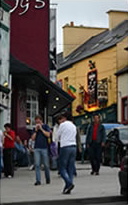 In those days there would have been check-points at the border, but travelling now I never even noticed a sign to say when I crossed from Northern Ireland to Eire. However, as I drove through Ballyshannon I had no doubts that I was in the South: bright coloured shop fronts and ramshackle road signs, a country whose spirit is far more like southern Europe, than the cooler Northern blood that often mistakes tidiness for godliness — what happened to the hot fire that flowed through the veins of Visgoth and Viking?
In those days there would have been check-points at the border, but travelling now I never even noticed a sign to say when I crossed from Northern Ireland to Eire. However, as I drove through Ballyshannon I had no doubts that I was in the South: bright coloured shop fronts and ramshackle road signs, a country whose spirit is far more like southern Europe, than the cooler Northern blood that often mistakes tidiness for godliness — what happened to the hot fire that flowed through the veins of Visgoth and Viking?
I would have loved to have more time to stop along the way, camp on Boa Island at the top of Loch Erne looking out at the hills that tumble into the water across the Loch, or climbing Benbulben that, while gentler from the West and South, to the North rises square faced and square sided like a wooden-block mountain in child’s counterpane landscape. However, I did not stop and drove on towards the West, through the thick traffic near Sligo, and on into the County Mayo countryside. It would have been good to stop and stare, to spend time savouring each place; and given time I would do so, but with limited time I always choose to move rather than stay, to feel the miles flow past whether by foot or car. Like the thirst for the western shore, the itinerant spirit runs deep in my heart, and as a child I dreamed of being a gypsy or a tramp, living along the paths of the land.
next Serendipity and Song — Westport to Doolin
- To be fair south of the border tourist shops accept payment in euro or US dollars, but not pounds (not even Scottish pounds), and on flag poles fly the flags of Ireland, the EU, USA, France, Germany, Italy … but never the UK.[back]
Roads of the Sea — Tiree to Larne
 Friday morning at 9am saw me at the ferry queue in Scarinish waiting for the Tiree–Oban ferry, saying goodbye to Fiona and to Tiree as I won’t be home again for most of the next two months. Friday is an early ferry — 5am check-in for those coming from Oban, but a more civilised time for going to the mainland and a 1pm arrival gives plenty of time to get down to Troon for the 8:20pm ferry.
Friday morning at 9am saw me at the ferry queue in Scarinish waiting for the Tiree–Oban ferry, saying goodbye to Fiona and to Tiree as I won’t be home again for most of the next two months. Friday is an early ferry — 5am check-in for those coming from Oban, but a more civilised time for going to the mainland and a 1pm arrival gives plenty of time to get down to Troon for the 8:20pm ferry.
I’ve never taken the Troon–Larne ferry before, always travelling to Ireland from Stranraer in the North or Holyhead in the South. However, arriving with a full three hours to spare, I found it is a good place to wait, eating a late picnic lunch of pork pie and salad overlooking the bay with windsurfers and kite surfers along the strand, home from home.
Long distance ‘commutes’ and remote relationships have become common amongst professional workers. I recall Richard Bentley at one stage working in Germany while his partner was in Jersey, and in the States several West-Coast East-Coast marriages. However, this is not a recent phenomena, on Tiree there are families of trawler men or those working on the North Sea rigs, where ‘going to work’ means many weeks or months away. The ‘Express’ Troon–Larne ferry fairly sped along compared with Calmac’s more leisurely vessels, and as I sat and watched us pass Ailsa Craig, struck up conversation with a man on his way home to his wife and family after three months away doing forestry work in Scotland.
Larne, like Crewe, is a place you pass through and rarely stop, but given the late ferry I ended up spending a night there in a small seafront guesthouse, Beach Vista. The late arrival of the ferry was compounded by a wrong turning1, but despite the late hour Bob the proprietor was waiting with a warm welcome in a rich Northern accent. My childhood images of Northern Ireland are all from news stories of ‘The Troubles’; amidst these images of sectarian violence and bomb blasts, it is easy to forget the warmth of the people and the beauty of the countryside. So I spent a first peaceful night, hearing the sound of the waves lapping against the sea wall.
Walking along the seashore before breakfast, watching a freight ship glide quietly into port past the James Chaine memorial tower, I understood some of Bob’s love of the place. “Sometimes when my wife and I go away on holiday”, he told me, “we sometimes just wonder why, when we have this at home”. Despite being less than an hour from Belfast, the pace of life is clearly somewhat slower in Larne. Bob, as well as running the B&B with his family, also has a Taxi firm, and explained that, just like on Tiree, he doesn’t worry about locking the taxi and even leaving the keys inside.
next Into the West — Larne to Westport
- why can’t Google maps include a scale on the printed maps![back]
endings and beginnings: cycling, HR and Talis
It is the end of the summer, the September rush starts (actually at the end of August) and on Friday I’ll be setting off on the ferry and be away from home for all of September and October 🙁 Of course I didn’t manage to accomplish as much as I wanted over the summer, and didn’t get away on holiday … except of course living next to the sea is sort of like holiday every day! However, I did take some time off when Miriam visited, joining her on cycle rides to start her training for her Kenyan challenge — neither of us had been on a bike for 10 years! Also this last weekend saw the world come to Tiree when a group of asylum seekers and refugees from the St Augustine Centre in Halifax visited the Baptist Church here — kite making, songs from Zimbabwe and loads of smiling faces.
In September I also hand over departmental personnel duty (good luck Keith :-)). I’d taken on the HR role before my switch to part-time at the University, and so most of it stayed with me through the year 🙁 (Note, if you ever switch to part-time, better to do so before duties are arranged!). Not sorry to see it go, the people bit is fine, but so much paper filling!
 … and beginnings … in September (next week!) I also start to work part-time with Talis. Talis is a remarkable story. A library information systems company that re-invented itself as a Semantic Web company and now, amongst other things, powering the Linked Data at data.gov.uk.
… and beginnings … in September (next week!) I also start to work part-time with Talis. Talis is a remarkable story. A library information systems company that re-invented itself as a Semantic Web company and now, amongst other things, powering the Linked Data at data.gov.uk.
I’ve known Talis as a company from its pre-SemWeb days when aQtive did some development for them as part of our bid to survive the post-dot.com crash. aQtive did in the end die, but Talis had stronger foundations and has thrived1. In the years afterwards two ex-aQtive folk, Justin and Nad, went to Talis and for the past couple of years I have also been on the external advisory group for their SemWeb Platform. So I will be joining old friends as well as being part of an exciting enterprise.
- Libraries literally need very strong foundations. I heard of one university library that had to be left half empty because the architect had forgotten to take account of the weight of books. As the shelves filled the whole building began to sink into the ground.[back]
online PHP 5.3 syntax checker
My online PHP syntax checker (mentioned in earlier post) now has option to check PHP5.3. There are still options to check PHP 4 and PHP 5.2, which should cover major syntax variations.
fixing hung iCal
iCal hung on a sync with Google calendars and kept hanging everytime I restarted it, even after restarting the whole machine.
I found some advice on this in a few posts.
One “Fix an iCal ‘application not responding’ occasional hang” was more about occasional long pauses and suggested selecting”Reset Sync History” in “iSync » Preferences”. Another “Fix an iCal hang due to system date reset” suggested resetting the ‘lastHearBeatDate‘ in Library/Preferences/com.apple.iCal.plist. Neither worked, but prompted by the latter I used TimeMachine (yawn yawn how do they make it sooooo sloooow), to restore copies of all the iCal plist files in Library/Preferences/, but again to no avail.
So several good suggestions, but none worked.
Happily I saw a comment lower down on “Fix an iCal hang due to system date reset” which suggested moving the complete ~/Library/Calendars folder out to the desktop and then recopying the calendar files in one by one after restarting iCal. I didn’t do this as such, but instead in ~/Library/Calendars there are a number of ‘Calendar Cache‘ files and also a folder labelled Calendar Sync Changes. I removed these, restarted and … it works 🙂
Hardly easy for the end user though :-/
Struggling with Heidegger
Heidegger and hammers have been part of HCI’s conceptualisation from pretty much as long as I can recall. Although maybe I first heard the words at some sort of day workshop in the late 1980s as the hammer example as used in HCI annoyed me even then, so let’s start with hammers.
hammers
I should explain that problems with the hammer example are not my current struggles with Heidegger! For the hammer it is just that Heidegger’s ‘ready at hand’ is often confused with ‘walk up and use’. In Heidegger ready-at-hand refers to the way one is focused on the nail, or wood to be joined, not the hammer itself:
“The work to be produced is the “towards which” of such things as the hammer, the plane, and the needle” (Being and Time1, p.70/99)
To be ‘ready to hand’ like this typically requires familiarity with the equipment (another big Heidegger word!), and is very different from the way a cash machine or tourist information systems should be in some ways accessible independent of prior knowledge (or at least only generic knowledge and skills).
My especial annoyance with the hammer example stems from the fact that my father was a carpenter and I reckon it took me around 10 years to learn how to use a hammer properly2! Even holding it properly is not obvious, look at the picture.

There is a hand sized depression in the middle. If you have read Norman’s POET you will think, “ah yes perceptual affordance’, and grasp it like this:

But no that is not the way to hold it! If try to use it like this you end up using the strength of your arm to knock in the nail and not the weight of the hammer.
Give it to a child, surely the ultimate test of ‘walk up and use’, and they often grasp the head like this.

In fact this is quite sensible for a child as a ‘proper’ grip would put too much strain on their wrist. Recall Gibson’s definition of affordance was relational3, about the ecological fit between the object and the potential actions, and the actions depends on who is doing the acting. For a small child with weaker arms the hammer probably only affords use at all with this grip.
In fact the ‘proper’ grip is to hold it quite near the end where you can use the maximum swing of the hammer to make most use of the weight of the hammer and its angular momentum:

Anyway, I think maybe Heidegger knew this even if many who quote him don’t!
Heidegger
OK, so its alright me complaining about other people mis-using Heidegger, but I am in the middle of writing one of the chapters for TouchIT and so need to make sure I don’t get it wrong myself … and there my struggles begin. I need to write about ready-to-hand and present-to-hand. I thought I understood them, but always it has been from secondary sources and as I sat with Being and Time in one hand, my Oxford Companion to Philosophy in another and various other books in my teeth … I began to doubt.
First of all what I thought the distinction was:
- ready at hand — when you are using the tool and it is invisible to you, you just focus on the work to be done with it
- present at hand — when there is some sort of breakdown, the hammer head is loose or you don’t have the right tool to hand and so start to focus on the tools themsleves rather than on the job at hand
Scanning the internet this is certainly what others think, for example blog posts at 251 philosophy and Matt Webb at Berg4. Koschmann, Kuutti and Hickman produced an excellent comparison of breakdown in Heidegger, Leont’ev and Dewey5, and from this it looks as though the above distinction maybe comes Dreyfus summary of Heidegger — but again I don’t have a copy of Dreyfus’ “Being-in-the-World“, so not certain.
Now this is an important distinction, and one that Heidegger certainly makes. The first part is very clearly what Heidegger means by ready-to-hand:
“The peculiarity of what is proximally to hand is that, in its readiness-to-hand, it must, as it were, withdraw … that with which we concern ourselves primarily is the work …” (B&T, p.69/99)
The second point Heidegger also makes at length distinguishing at least three kinds of breakdown situation. It just seems a lot less clear whether ‘present-at-hand’ is really the right term for it. Certainly the ‘present-at-hand’ quality of an artefact becomes foregrounded during breakdown:
“Pure presence at hand announces itself in such equipment, but only to withdraw to the readiness-in-hand with which one concerns oneself — that is to say, of the sort of thing we find when we put it back into repair.” (B&T, p.73/103)
But the preceeding sentance says
“it shows itself as an equipmental Thing which looks so and so, and which, in its readiness-to-hand as looking that way, has constantly been present-at-hand too.” (B&T, p.73/103)
That is present-at-hand is not so much in contrast to ready-at-hand, but in a sense ‘there all along’; the difference is that during breakdown the presence-at-hand becomes foregrounded. Indeed when ‘present-at-hand’ is first introduced Heidegger appears to be using it as a binary distinction between Dasein, (human) entities that exist and ponder their existence, and other entities such as a table, rock or tree (p. 42/67). The contrast is not so much between ready-to-hand and present-to-hand, but between ready-to-hand and ‘just present-at-hand’ (p.71/101) or ‘Being-just-present-at-hand-and-no-more’ (p.73/103). For Heidegger to seems not so much that ‘ready-to-hand’ stands in in opposition to ‘present-to-hand’; it is just more significant.
To put this in context, traditional philosophy had focused exclusively on the more categorically defined aspects of things as they are in the world (‘existentia’/present-at-hand), whilst ignoring the primary way they are encountered by us (Dasein, real knowing existence) as ready-to-hand, invisible in their purposefulness. Heidegger seeks to redress this.
“If we look at Things just ‘theoretically’, we can get along without understanding readiness-to-hand.” (B&T p.69/98)
Heidegger wants to avoid the speculation of previous science and philosophy. Although it is not a Heidegger word, I use ‘speculation’ here with all of its connotations, pondering at a distance, but without commitment, or like spectators at a sports stadium looking in at something distant and other. In contrast, ready-to-hand suggests commitment, being actively ‘in the world’ and even when Heidegger talks about those moments when an entity ceases to be ready-to-hand and is seen as present-to-hand, he uses the term circumspection — a casting of the eye around, so that the Dasein, the person, is in the centre.
So present-at-hand is simply the mode of being of the entities that are not Dasein (aware of their own existence), but our primary mode of experience of them and thus in a sense the essence of their real existence is when they are ready-to-hand. I note Roderick Munday’s useful “Glossary of Terms in Being and Time” highlights just this broader sense of present-at-hand.
Maybe the confusion arises because Heidegger’s concern is phenomenological and so when an artefact is ready-to-hand and its presence-to-hand ‘withdraws’, in a sense it is no longer present-to-hand as this is no longer a phenomenon; and yet he also seems to hold a foot in realism and so in another sense it is still present-to-hand. In discussing this tension between realism and idealism in Heidegger, Stepanich6 distinguishes present-at-hand and ready-to-hand, from presence-to-hand and readiness-to-hand — however no-one else does this so maybe that is a little too subtle!
To end this section (almost) with Heidegger’s words, a key statement, often quoted, seems to say precisely what I have argued above, or maybe precisely the opposite:
“Yet only by reason of something present-at-hand ‘is there’ anything ready-to-hand. Does it follow, however, granting this thesis for the nonce, that readiness-to-hand is ontologically founded upon presence-at-hand?” (B&T, p.71/101)
What sort of philosopher makes a key point through a rhetorical question?
So, for TouchIT, maybe my safest course is to follow the example of the Oxford Companion to Philosophy, which describes ready-to-hand, but circumspectly never mentions present-to-hand at all?
and anyway what’s wrong with …
On a last note there is another confusion, or maybe mistaken attitude, that seems to be common when referring to ready-to-hand. Heidegger’s concern was in ontology, understanding the nature of being, and so he asserted the ontological primacy of the ready-to-hand, especially in light of the previous dominant concerns of philosophy. However, in HCI, where we are interested not in the philosophical question, but the pragmatic one of utility, usability, and experience, Heidegger is often misapplied as a kind of fetishism of engagement, as if everything should be ready-to-hand all the time.
Of course for many purposes this is correct, as I type I do not want to be aware of the keys I press, not even of the pages of the book that I turn.
Yet there is also a merit in breaking this engagement, to encourage reflection and indeed the circumspection that Heidegger discusses. Indeed Gaver et al.’s focus on ambiguity in design7 is often just to encourage that reflection and questioning, bringing things to the foreground that were once background.
Furthermore as HCI practitioners and academics we need to both take seriously the ready-to-hand-ness of effective design, but also (just as Heidegger is doing) actually look at the ready-to-hand-ness of things seeing them and their use not taking them for granted. I constantly strive to find ways to become aware of the mundane, and offer students tools for estrangement to look at the world askance8.
“To lay bare what is just present-at-hand and no more, cognition must first penetrate beyond what is ready-to-hand in our concern.” (B&T, p.71/101)
This ability to step out and be aware of what we are doing is precisely the quality that Schon recognises as being critical for the ‘Reflective Practioner‘. Indeed, my practical advice on using the hammer in the footnotes below comes precisely through reflection on hammering, and breakdowns in hammering, not through the times when the hammer was ready-to-hand..
Heidegger is indeed right that our primary existence is being in the world, not abstractly viewing it from afar. And yet, sometimes also, just as Heidegger himself did as he pondered and wrote about these issues, one of our crowning glories as human beings is precisely that we are able also in a sense to step outside ourselves and look in wonder.
- In common with much of the literature the page references to Being and Time are all of the form p.70/99 where the first number refers to the page numbers in the original German (which I have not read!) and the second number to the page in Macquarrie and Robinson’s translation of Being and Time published by Blackwell.[back]
- Practical hammering – a few tips: The key thing is to focus on making sure the face of the hammer is perpendicular to the nail, if there is a slight angle the nail will bend. For thin oval wire nails, if one does bend do not knock the nail back upright, most likely it will simply bend again and just snap. Instead, simply hit the head of the nail while still bent, but keeping the hammer face perpendicular to the nail not the hole. So long as the nail has cut any depth of hole it will simply follow its own path and straighten of its own accord.[back]
- James Gibson. The Ecological Approach to Visual Perception[back]
- Matt Webb’s post appears to be quoting Paul Dourish’ “Where the Action Is”, but I must have lent my copy to someone, so not sure of this is really what Paul thinks.[back]
- Koschmann, T., Kuutti, K. & Hickman, L. (1998). The Concept of Breakdown in Heidegger, Leont’ev, and Dewey and Its Implications for Education. Mind, Culture, and Activity, 5(1), 25-41. doi:10.1207/s15327884mca0501_3[back]
- Lambert Stepanich. “Heidegger: Between Idealism and Realism“, The Harvard Review of Philosophy, Vol 1. Spring 1991.[back]
- Bill Gaver, Jacob Beaver, and Steve Benford, 2003. Ambiguity as a resource for design. CHI ’03.[back]
- see previous posts on “mirrors and estrangement” and “the ordinary and the normal“[back]
Names, URIs and why the web discards 50 years of computing experience
Names and naming have always been a big issue both in computer science and philosophy, and a topic I have posted on before (see “names – a file by any other name“).
In computer science, and in particular programming languages, a whole vocabulary has arisen to talk about names: scope, binding, referential transparency. As in philosophy, it is typically the association between a name and its ‘meaning’ that is of interest. Names and words, whether in programming languages or day-to-day language, are, what philosophers call, ‘intentional‘: they refer to something else. In computer science the ‘something else’ is typically some data or code or a placeholder/variable containing data or code, and the key question of semantics or ‘meaning’ is about how to identify which variable, function or piece of data a name refers to in a particular context at a particular time.
The emphasis in computing has tended to be about:
(a) Making sure names have unambiguous meaning when looking locally inside code. Concerns such as referential transparency, avoiding dynamic binding and the deprecation of global variables are about this.
(b) Putting boundaries on where names can be seen/understood, both as a means to ensure (a) and also as part of encapsulation of semantics in object-based languages and abstract data types.
However, there has always been a tension between clarity of intention (in both the normal and philosophical sense) and abstraction/reuse. If names are totally unambiguous then it becomes impossible to say general things. Without a level of controlled ambiguity in language a legal statement such as “if a driver exceeds the speed limit they will be fined” would need to be stated separately for every citizen. Similarly in computing when we write:
function f(x) { return (x+1)*(x-1); }
The meaning of x is different when we use it in ‘f(2)’ or ‘f(3)’ and must be so to allow ‘f’ to be used generically. Crucially there is no internal ambiguity, the two ‘x’s refer to the same thing in a particular invocation of ‘f’, but the precise meaning of ‘x’ for each invocation is achieved by external binding (the argument list ‘(2)’).
Come the web and URLs and URIs.
Fiona@lovefibre was recently making a test copy of a website built using WordPress. In a pure html website, this is easy (so long as you have used relative or site-relative links within the site), you just copy the files and put them in the new location and they work 🙂 Occasionally a more dynamic site does need to know its global name (URL), for example if you want to send a link in an email, but this can usually be achieved using configuration file. For example, there is a development version of Snip!t at cardiff.snip!t.org (rather then www.snipit.org), and there is just one configuration file that needs to be changed between this test site and the live one.
Similarly in a pristine WordPress install there is just such a configuration file and one or two database entries. However, as soon as it has been used to create a site, the database content becomes filled with URLs. Some are in clear locations, but many are embedded within HTML fields or serialised plugin options. Copying and moving the database requires a series of SQL updates with string replacements matching the old site name and replacing it with the new — both tedious and needing extreme care not to corrupt the database in the process.
Is this just a case of WordPress being poorly engineered?
In fact I feel more a problem endemic in the web and driven largely by the URL.
Recently I was experimenting with Firefox extensions. Being a good 21st century programmer I simply found an existing extension that was roughly similar to what I was after and started to alter it. First of course I changed its name and then found I needed to make changes through pretty much every file in the extension as the knowledge of the extension name seemed to permeate to the lowest level of the code. To be fair XUL has mechanisms to achieve a level of encapsulation introducing local URIs through the ‘chrome:’ naming scheme and having been through the process once. I maybe understand a bit better how to design extensions to make them less reliant on the external name, and also which names need to be changed and which are more like the ‘x’ in the ‘f(x)’ example. However, despite this, the experience was so different to the levels of encapsulation I have learnt to take for granted in traditional programming.
Much of the trouble resides with the URL. Going back to the two issues of naming, the URL focuses strongly on (a) making the name unambiguous by having a single universal namespace; URLs are a bit like saying “let’s not just refer to ‘Alan’, but ‘the person with UK National Insurance Number XXXX’ so we know precisely who we are talking about”. Of course this focus on uniqueness of naming has a consequential impact on generality and abstraction. There are many visitors on Tiree over the summer and maybe one day I meet one at the shop and then a few days later pass the same person out walking; I don’t need to know the persons NI number or URL in order to say it was the same person.
Back to Snip!t, over the summer I spent some time working on the XML-based extension mechanism. As soon as these became even slightly complex I found URLs sneaking in, just like the WordPress database 🙁 The use of namespaces in the XML file can reduce this by at least limiting full URLs to the XML header, but, still, embedded in every XML file are un-abstracted references … and my pride in keeping the test site and live site near identical was severely dented1.
In the years when the web was coming into being the Hypertext community had been reflecting on more than 30 years of practical experience, embodied particularly in the Dexter Model2. The Dexter model and some systems, such as Wendy Hall’s Microcosm3, incorporated external linkage; that is, the body of content had marked hot spots, but the association of these hot spots to other resources was in a separate external layer.
Sadly HTML opted for internal links in anchor and image tags in order to make html files self-contained, a pattern replicated across web technologies such as XML and RDF. At a practical level this is (i) why it is hard to have a single anchor link to multiple things, as was common in early Hypertext systems such as Intermedia, and (ii), as Fiona found, a real pain for maintenance!
- I actually resolved this by a nasty ‘hack’ of having internal functions alias the full site name when encountered and treating them as if they refer to the test site — very cludgy![back]
- Halasz, F. and Schwartz, M. 1994. The Dexter hypertext reference model. Commun. ACM 37, 2 (Feb. 1994), 30-39. DOI= http://doi.acm.org/10.1145/175235.175237[back]
- Hall, W., Davis, H., and Hutchings, G. 1996 Rethinking Hypermedia: the Microcosm Approach. Kluwer Academic Publishers.[back]


